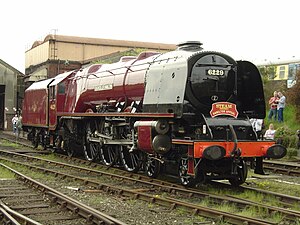LMS Coronation Class

No. 46229 in so called 'semi-streamlined' condition at Tyseley, 6 May 2006 prior to the addition of its streamlined casing.
|
|||||||||||||||||||||||||||||||||||||||||||||||||||||||||||||||||||||||||
|
|||||||||||||||||||||||||||||||||||||||||||||||||||||||||||||||||||||||||
|
|||||||||||||||||||||||||||||||||||||||||||||||||||||||||||||||||||||||||
|
|||||||||||||||||||||||||||||||||||||||||||||||||||||||||||||||||||||||||
|
|||||||||||||||||||||||||||||||||||||||||||||||||||||||||||||||||||||||||
| Type and origin | |
|---|---|
| Power type | Steam |
| Designer | William Stanier |
| Builder | LMS Crewe Works |
| Build date | 1937–1948 |
| Total produced | 38 |
| Specifications | |
|---|---|
| Configuration | 4-6-2 |
| UIC class | 2′C1′ h4 |
| Gauge | 4 ft 8 1⁄2 in (1,435 mm) |
| Leading dia. | 3 ft 0 in (0.914 m) |
| Driver dia. | 6 ft 9 in (2.057 m) |
| Trailing dia. | 3 ft 9 in (1.143 m) |
| Minimum curve |
|
| Wheelbase | 62 ft 11 in (19.177 m) |
| • Engine | 37 ft 0 in (11.278 m) |
| • Drivers | 14 ft 6 in (4.420 m) |
| • Tender | 15 ft 0 in (4.57 m) |
| Length |
|
| Height | 13 ft 3 in (4.039 m) |
| Loco weight |
|
| Tender weight |
|
| Fuel type | Coal |
| Fuel capacity | 10 long tons (11.2 short tons; 10.2 t) |
| Water cap | 4,000 imp gal (18,000 l; 4,800 US gal) |
| Firebox type | |
| • Firegrate area | 50 sq ft (4.6 m2) |
| Boiler: |
|
| • Model | LMS type 1X |
| • Tube plates | 19 ft 3 in (5.867 m) |
| • Small tubes | 2 3⁄8 in (60 mm), 129 off |
| • Large tubes | 5 1⁄8 in (130 mm), 40 off |
| Boiler pressure | 250 psi (1.72 MPa) |
| Heating surface | 2,807 sq ft (260.8 m2) |
| • Tubes and flues | 2,577 sq ft (239.4 m2) |
| • Firebox | 230 sq ft (21 m2) |
| Superheater: |
|
| • Heating area |
|
| Cylinders | 4 |
| Cylinder size | 16 1⁄2 in × 28 in (419 mm × 711 mm) |
| Valve gear | Walschaerts for outside cylinders with rocking shafts for inside cylinders |
| Valve type | Piston valves |
| Performance figures | |
|---|---|
| Tractive effort | 40,000 lbf (180 kN) |
| Career | |
|---|---|
| Operators | |
| Power class |
|
| Numbers |
|
| Withdrawn | 1962–1964 |
| Preserved | 6229, 6233, 6235 |
| Disposition | Three preserved, remainder scrapped |
The London Midland and Scottish Railway (LMS) Coronation Class, also known as Princess Coronation Class, is a class of express passenger steam locomotives designed by William Stanier. They were an enlarged and improved version of the LMS Princess Royal Class. Several examples were originally built as streamlined, though the streamlining was later removed. The non-streamlined locomotives built during 1938 were often referred to as Duchesses, though to enginemen they were often known as Big Lizzies.
They were the most powerful passenger steam locomotives ever to be built for the LMS network, estimated at around 3,300 horsepower (2,500 kW), making them far more powerful than the diesel engines that ultimately replaced them.
Three of these locomotives are preserved today.
Although the prior introduction of the Princess Royal class had provided the LMS with more powerful locomotives to be used on the main line between London Euston and Glasgow Central, it could be seen by 1936 that more such locomotives would be needed, particularly as it was intended to introduce a new non-stop service between those cities. Initially, it was planned to build five more Princess Royals, but the Chief Technical Assistant and Chief Draughtsman at the LMS Derby Works, Tom Coleman, persuaded Stanier that he could design a locomotive that was more powerful, more reliable and easier to maintain. Stanier was convinced and plans were put in progress to construct five locomotives of the new class. When Stanier was called on to perform an assignment in India, Coleman became responsible for most of the detailed design in his absence.
Compared to the Princess Royal Class, the main differences leading to increased power were a bigger boiler of great steam-raising capacity including a firebox heating surface of 230 sq ft (21 m2) versus 217 sq ft, a flue heating surface of 2,577 sq ft (239.4 m2) versus 2,299 sq ft, superheater surface area of 830 sq ft (77 m2) (some sources say 822 sq ft) versus 598 sq ft and a grate area of 50 sq ft (4.6 m2) versus 45 sq ft. The steam passages were also better streamlined for sustained high speed running. The driving wheels were increased to 6 ft 9 in (2.06 m) (from 6 ft 6in) for higher speed and cylinder diameters increased by 1⁄4 in (6.4 mm). Outside cylinders were moved forward and only two sets of outside valve gear were used with rocking shafts to operate the inside cylinders.
...
Wikipedia
